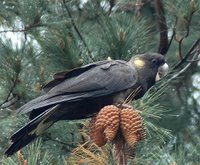 Even on a damp wet day, a Yellow-tailed Black Cockatoo has to eat.
Even on a damp wet day, a Yellow-tailed Black Cockatoo has to eat.These birds (Calytorhynchus funereus) love to eat the seeds of the Monterey Pine (Pinus Radiata). Those trees were planted heavily around Robertson, by the early settlers here, and so, there are great food resources here for the Black Cockies.
In fact the Black Cockies spread the seeds of the Pine trees, so successfully that the pines are something of a weed around Robertson. The Cockies spread the seed not by ingesting the seeds and passing them through. When a Cockatoo eats a seed like that, it is chewed very badly and damaged.
Getting down to Lunch
 No, what the Cockies do is steadily work on an entire pine cone, and then chew it off at the stalk, and often a bird will carry an entire cone away,
No, what the Cockies do is steadily work on an entire pine cone, and then chew it off at the stalk, and often a bird will carry an entire cone away,holding it in its beak. That is a fair achievement by a bird. It also makes them look very front-heavy when in flight - an odd sight indeed. Eventually, the Cockie gets fed up, literally, and will drop the cone, wherever it landed to eat it's "take-away" lunch. That is how such heavy cones get spread around Robertson, allowing seedling pine trees to sprout in new locations.
This bird is an adult female - with a pale brown beak.
"Can we go, now?"
 The second bird in this pair, was sitting above the "busy" one, totally bored, and soaked.
The second bird in this pair, was sitting above the "busy" one, totally bored, and soaked.If ever I saw a bird wanting to say "Can we go now?" it is this bird.
This bird is an adult male, with a dark brown-black beak, and a red eye ring.
The light was very poor, because of the rain. But the details of the bird's beak and eye ring are visible if you click on the photo to enlarge the image.

5 comments:
These are breathtaking :)
We have a lot of Quaker Parrots that have multiplied from being escapees/or let go by their owner. They are fun to watch in Palm tress. Such social creatures.
Do you see many Gala/Rose Breasted Cockatoos? I read that they flock in the hundreds and or regarded as pigeons to you guys!
I have seen a movie about feral parrots in San Francisco. Very interesting. We have too many "introduced birds" in Australia which become pests. But parrots are very adaptable, and people like them.
Galahs are very common in Canberra (our National capital) where I used live. They feed on the grass beside roadways, and on playing fields (at Schools, etc).
Where I now live (in Robertson) they are less common (a wetter area, which does not suit them so well). But we have a railway line, and wheat is carted through the village, on railway trucks. Some grain always spills, and Galahs feed along the line. I shall try and get some photos for you.
We do regard them as "common", but they are very pretty. Many people put out grain for them, and they get to be very tame.
Denis
Galah's are beautiful creaters.
I have seen the flick that you are referring to. An interesting film.
WE often see mixed flocks of Parrots that will include the Quakers (Monk Parakett) with a few Amazon Parrots and Nanday Conures. The Nanday Conures are extremely loud for a bird of that size!
Have you explored my blog? I am slowing adding more blogs of my trips.
I want to go to the everglades before it warms up again! I want to see some of those monster pythons that are taking over. Did you see the pictures or the National Geographic special on the python that ate a good sized alligator and was attached by another alligator afterwards and the snake's belly exploded? Quite interesting! I will lokk fo a link of this.
I just posted a bog about the python vs. alligoator that I referred to few minutes ago. Check it out: http://joec66.blogspot.com/2008/02/can-you-imagine-stumbling-across-this.html
Post a Comment